How Schools Make “Making” Meaningful
“What’s the difference between a makerspace and a great makerspace?” asks Laura Fleming, library/media specialist at New Milford High School in New Milford (NJ), and author of The Kickstart Guide to Making Great Makerspaces (Corwin Press). “Great makerspaces are unique to your school community, relevant to your world, meaningful, and sustainable.”
Just as we’ve learned with strong 1:1 initiatives that it’s not about the device, makerspaces are not about the products. On the contrary, Fleming says successful makerspaces allow students to connect to their curriculum, their community, and the world.
To improve your makerspace, she suggests asking students what they want to learn about. If you want it to appeal to girls, ask the girls what they want. Assess your curriculum, clubs, programs, activities, and offerings, because your makerspace can leverage what’s already happening or it can fill in the gaps. You can even get ideas from global trends, particularly business-related ones. “Last year, every time I turned on the news I saw something about drones,” says Fleming. “They were everywhere—except in our curriculum—so we chose flight as a theme for our makerspace and integrated drones into it.”
When done right, your makerspace can extend learning opportunities and take students to incredible places. Here are some stellar examples.
AN OUTDOOR MAKERSPACE

When Curtis Slater became principal of Wyoming Elementary School in Wyoming (MN), he joined a high-poverty school with little tax revenue and an outdated tech lab. He started writing grants, quickly secured funding for three Chromebook carts, and turned the tech lab into a makerspace. He helped to hook teachers by taking over classes in the makerspace and demonstrating what they could do, and now teachers check out plastic bins of materials to bring to their classrooms, the media center, and even the gym.
But something fascinating happened when Slater turned a never-used outdoor volleyball court into a sandbox and bought $10 worth of shovels and pails at a garage sale. “It was magic,” he says. “Children who didn’t play on the playground or do sports went to the sandbox and began making a village. It started with four kids and grew to 30 or more every recess, collaborating and making roads.” Based on that response, Slater wrote more grants for additional equipment and is working with Tonka to get additional tools. Slater discovered that the sandbox helped to decrease physical aggression incidents. This year, he’s encouraging students to take pictures and document their progress. He’s also planning to buy Lincoln Logs so the children can build forts and role-play.
Tools and ideas to transform education. Sign up below.
“How many kids leave recess feeling rejected because they didn’t get picked for a team or are always ‘it’ in tag?” asks Curtis. “With our sandbox makerspace, they feel like they are part of something and are proud. Parents love it, too.”
MAKING ISN’T JUST A STEM THING
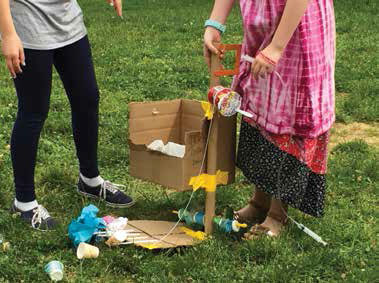
Baltimore County (MD) Public Schools (BCPS) encourages making throughout the whole district, emphasizing hands-on learning in every classroom and via the BCPS Mobile Innovation Lab, a traveling makerspace in a converted school bus. The district is also developing a Maker Lending Library that will offer training for teachers and let them sign out tools to bring back to their classrooms.
Margaret Koenig, who teaches fourth- and fifth-grade science at Hillcrest Elementary School, has been weaving making into her lessons for years. As chair of the innovation team, she also helps her colleagues integrate making into their classes. “One of my passions is showing others that making doesn’t just work best in a STEM situation,” she says. “That’s what a lot of teachers associate it with.” In fact, Koenig often has students do maker projects in English Language Arts. Last year, the fifth graders read The True Confessions of Charlotte Doyle, a novel about a wealthy 13-year-old girl who encounters a lot of problems while sailing from England to the United States in the mid-1800s. Koenig shared an article about a 14-year-old who invented a vending machine that dispensed first-aid materials and asked the students to design and create items to stock on a vending machine for Charlotte Doyle’s ship. Through their research, the students learned that Japanese vending machines sell everything from umbrellas to pizzas. They also studied seasickness remedies from the 1800s. Next, they used makerspace materials to create a toad to kill cockroaches, miniature dresses in case Charlotte ran out of clean clothes, and other vending machine-sized items. “They were so creative and really pushed themselves. I also discovered that a lot of my students can sew!” says Koenig.
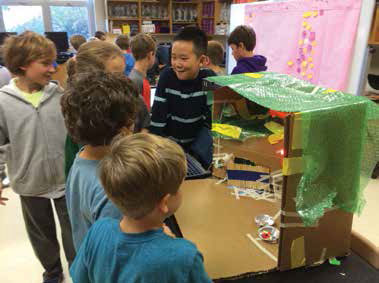
Koenig introduced another makerspace project by challenging her students to design something to protect the big red emergency shutoff buttons in her science lab. The buttons, which are at shoulder height, tend to be hit “accidentally”—especially when there’s a substitute in the room. She says the students had tons of clever ideas, including lining the surrounding area with bubble wrap.
To help her students better understand ratios, one of Koenig’s colleagues asked her students to select one of the Seven Wonders of the Ancient World and use makerspace materials to build a scale model. They also had to have documentation that showed the proper proportions. Koenig’s takeaway: “You can never have enough colorful duct tape, especially fluorescent pink.”
CALLING ALL FUTURE ARCHITECTS
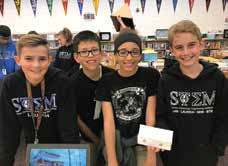
STEM Launch K–8, which is part of the Adams (CO) 12 Five Star Schools, incorporates making into most of its project-based learning (PBL) curriculum. The school serves a high-risk population, and students work with industry partners to help solve problems. At the beginning of last year, students analyzed back-to-school products and created prototypes of redesigned chairs, headphones, and other items. As they do with all of these projects, they presented their designs to a panel of industry partners. “We don’t just do expert panels at the end of our projects, since that provides only minimal feedback,” says Kate Klaver, STEM coordinator. “Instead, we bring people in throughout the process so the students can use feedback to improve the next design.”
When sixth-graders were struggling with area, perimeter, and geometry standards, their teachers gave them links to articles about Denver’s housing crisis and encouraged them to figure out a solution with design. At the time, tiny home shows were all the rage, so the students decided to focus on tiny homes. They studied the industry, went to the Denver Home Show, and a tiny home designer visited the class to discuss his work. At the Denver Home Show, a company called Rainbow Tiny Homes asked to partner with the school; the company gave the students design parameters and told them they would choose one of their designs to build. The students used Fab@School Maker Studio, a Web-based design and fabrication tool, to design their own tiny homes. They made blueprints, used 3D fabricators, 3D printers, screen printers, paint, and other tools, and incorporated statistics and facts about the housing shortage into their projects.
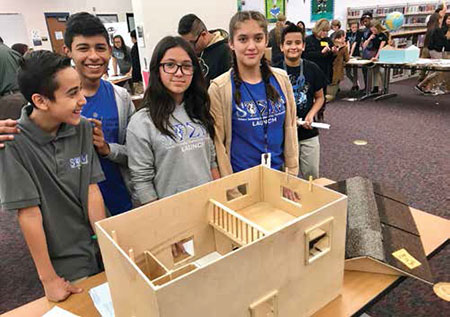
Fourth-graders worked with their engineering and art teacher to figure out how to make their K–8 school look less like a middle school and more like a K–8 school. They decided it needed more student-generated art, so they visited a sculpture garden, spoke to artists who specialize in metal sculptures, and designed outdoor sculptures. In art, they designed; in engineering, they made sure their prototypes were structurally sound. After a panel of district architects and facilities staff reviewed their designs, they began fundraising so they can create the pieces.
The school’s philosophy is that everyone can use makerspace materials to bring student and teacher ideas to life. As Klaver says, “We try to get all students involved with the makerspace by giving them the tools and letting them run with them.”
A MAKERSPACE WHERE SOCIAL-EMOTIONAL LEARNING THRIVES
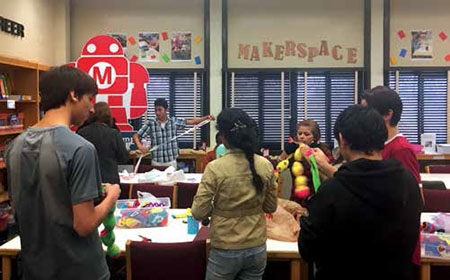
As Islip (NY) High School’s library media specialist, Gina Seymour collaborates with classroom teachers all the time. Her goal is for the makerspace to be meaningful and connected to the curriculum, not something extra or special. “I want students to understand that the makerspace is the real-world application of what they were talking about in class,” says Seymour.
She tells teachers that one easy way to integrate making in science labs is to hand out wind tubes, marble runs, littleBits, and Snap Circuits. “Let students tinker and experiment,” she says. “They reach the same conclusion as they would have with a prescriptive lab assignment, but they understand it better and are more excited.”
Seymour’s makerspace is always open, so student drop in during lunch or free periods and do what they want. Before midterms, she offered maker activities like coloring and puzzles that develop mindfulness and confidence. (See more ideas on her blog at https://ginaseymour.com/.)
A really cool turning point for Seymour was seeing how much her students enjoy using the makerspace to help others. At the beginning of the 2016–17 school year, a student who had graduated in June was killed in a car accident. Needless to say, the community was heartbroken. “We set up a button-making station in the library so people could make memorial buttons for homecoming and other events to honor him. I saw how makerspaces can address social-emotional learning as well as academic learning.”
Students began making items for events and service-learning projects, such as dog and cat toys for the animal shelter and sleep masks for the homeless population. She paired up with the sewing teachers, and students turned pillowcases into dresses for Little Dresses for Africa. Last spring, Seymour worked with the AP environmental science and marine biology teachers on a project in which students repurposed plastic bags into jump ropes for the elementary school field day. “They were studying sustainability and reading One Plastic Bag. The project paired perfectly with the curriculum,” she says.
